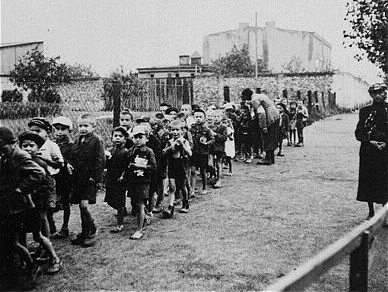The Kulmhof extermination camp, located on the Ner River, in Polish “Chełmno nad Nerem”, began operating in autumn 1941 in the Warthegau (Wartheland). The camp was the site of the immediate death of Jews from the Warthegau, as well as Roma and Sinti. A number of Poles also died there. According to estimates, between 150,000 and 250,000 people lost their lives at Kulmhof.
The choice of location was not accidental. Kulmhof was situated in the part of the Warthegau with the largest number of ghettos, including the ghetto in Lodz, about 60 km away. Also, decisive factor was the convenient railway connections between Kulmhof and Koło, which in turn connected Łódź and Poznań. A deserted neo-Gothic palace, a classicist granary and about 3 hectares of adjacent park and gardens were used to house the newly established camp. At first glance, the buildings did not arouse the suspicions of the victims.
The camp commandant was Herbert Lange (1940 – March 1942). Around 120-130 SS men worked there permanently. It was Lange who initiated the killing method involving the use of carbon dioxide, which was emitted from the exhaust fumes of trucks in so-called mobile gas chambers. Before Lange was sent to the camp, he had previously tested this method of killing during the T-4 operation. Initially, trucks manufactured by Dogde, Mercedes and Saurer were adapted for murderous purposes, and later suitably prepared cars were supplied by the Berlin-based German company Gaubschat Fahrzeugwerke GmbH.
People arriving in Chelmno were told that they would be sent to labour camps. Then, stripped for a supposed bath, they were led into hermetically sealed cars where exhaust fumes were discharged. Some prisoners were shot. The bodies of the executed people were transported to the nearby Rzuchowski Forest, where they were buried in mass graves. In the summer of 1942, the burial pits were unearthed by the Germans, and they began to burn the corpses, obliterating the traces of their crimes. For this purpose, crematoria were built so that the bodies of victims from subsequent transports could also be burned more efficiently. However, in the spring of 1943 the camp was closed, and the buildings (including the former palace and crematoria) were blown up.
Kulmhof remained closed until June 1944. Mass murders started again when transports from Łódź arrived. The extermination campaign resumed in time before the arrival of the Red Army. Finally, the camp ceased to exist on 17 January 1945, on the eve of the Soviet army’s entry.





